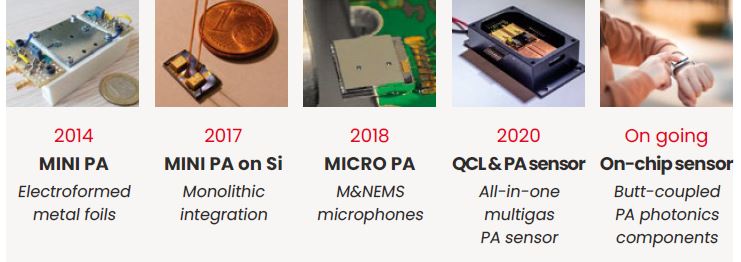μPAsense
Together, light and acoustic waves offer selective, sensitive chemical sensing
This photoacoustic spectroscopy technique is based on the absorption of light by molecules of interest and the subsequent generation of acoustic waves. Typically used for high-resolution mid-IR spectroscopy, this technique is currently limited to laboratory applications due to equipment size and cost.
CEA-Leti's μPAsense is a compact photoacoustic sensor operating in the mid-infrared range. It consists of a multiwavelength quantum cascade laser (QCL) source with a photonic integrated circuit (PIC) combiner in a compact photoacoustic cell. It can perform multi-gas chemical detection with a level of sensitivity down to just a few parts per billion.
What it can do
The selective, highly-sensitive chemical sensing capabilities offered by CEA-Leti's μPAsense technology are useful for a variety of applications:
Medicine, health, and wellness Environmental monitoring, food manufacturing, and farming Industrial process control Mobility New energy industries
|
What makes it unique
The current focus is on miniaturization of the sensor at chip or packaging level to address cost reduction, multi-gas selective and sensitive detection, and portability. Key milestones toward miniaturization already achieved:
- An effective fabrication process for QCL sources on silicon has been developed. The wavelength of each laser is selected independently after growth of the epitaxial layers.
- Low-loss waveguides based on Ge and SiGe alloys for PIC combiner fabrication, with optical losses as low as <1dB/cm within the 3 μm– 12 μm range.
- Mini acoustic Helmholtz detectors based on MEMS microphones have been fabricated on silicon and are suitable for trace-gas detection.
|
 Timeline of CEA-Leti developments on μPAsense technology
Timeline of CEA-Leti developments on μPAsense technology
Working with CEA-Leti
CEA-Leti is prepared to scale up and transfer the QCL technology and the silicon photoacoustic cell and is developing ultra-miniaturized sensors for selective and sensitive detection of chemicals in gas or liquids.
Companies of all types and sizes can work with CEA-Leti to develop sensors and sensing systems leveraging this breakthrough technology. With a proven R&D partnership management processes and robust intellectual property policies, CEA-Leti is poised to bring new ideas from the lab to fab securely and efficiently.
|